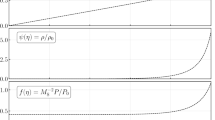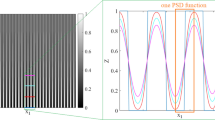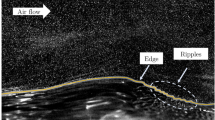Abstract
This paper presents improved statistical insight regarding the self-similar scalar mixing process of atmospheric hydrogen jets and the downstream region of under-expanded hydrogen jets. Quantitative planar laser Rayleigh scattering imaging is used to probe both jets. The self-similarity of statistical moments up to the sixth order (beyond the literature established second order) is documented in both cases. This is achieved using a novel self-similar normalization method that facilitated a degree of statistical convergence that is typically limited to continuous, point-based measurements. This demonstrates that image-based measurements of a limited number of samples can be used for self-similar scalar mixing studies. Both jets exhibit the same radial trends of these moments demonstrating that advanced atmospheric self-similarity can be applied in the analysis of under-expanded jets. Self-similar histograms away from the centerline are shown to be the combination of two distributions. The first is attributed to turbulent mixing. The second, a symmetric Poisson-type distribution centered on zero mass fraction, progressively becomes the dominant and eventually sole distribution at the edge of the jet. This distribution is attributed to shot noise-affected pure air measurements, rather than a diffusive superlayer at the jet boundary. This conclusion is reached after a rigorous measurement uncertainty analysis and inspection of pure air data collected with each hydrogen data set. A threshold based upon the measurement noise analysis is used to separate the turbulent and pure air data, and thusly estimate intermittency. Beta-distributions (four parameters) are used to accurately represent the turbulent distribution moments. This combination of measured intermittency and four-parameter beta-distributions constitutes a new, simple approach to model scalar mixing. Comparisons between global moments from the data and moments calculated using the proposed model show excellent agreement. This was attributed to the high quality of the measurements which reduced the width of the correctly identified, noise-affected pure air distribution, with respect to the turbulent mixing distribution. The ignitability of the atmospheric jet is determined using the flammability factor calculated from both kernel density estimated (KDE) PDFs and PDFs generated using the newly proposed model. Agreement between contours from both approaches is excellent. Ignitability of the under-expanded jet is also calculated using KDE PDFs. Contours are compared with those calculated by applying the atmospheric model to the under-expanded jet. Once again, agreement is excellent. This work demonstrates that self-similar scalar mixing statistics and ignitability of atmospheric jets can be accurately described by the proposed model. This description can be applied with confidence to under-expanded jets, which are more realistic of leak and fuel injection scenarios.




















Similar content being viewed by others
Abbreviations
- R :
-
Raw instantaneous Rayleigh scatter image
- p F :
-
Instantaneous laser energy fluctuation
- S T :
-
Instantaneous laser sheet profile
- S B :
-
Scattering background
- O R :
-
Optical response of collection lens and CCD chip
- B G :
-
Ambient background
- E B :
-
Electronic bias (Dc offset)
- I :
-
Instantaneous photon intensity image of jet
- I H2 :
-
Pixel intensity of hydrogen
- I AIR :
-
Pixel intensity of air
- χ H2 :
-
Hydrogen mol fraction
- Y :
-
Hydrogen mass fraction
- \(\bar{R}_{\text{AIR}}\) :
-
Ensemble mean pure air image
- \(\bar{R}_{\text{HE}}\) :
-
Ensemble mean pure helium image
- \(Y_{\text{CL}}^{'}\) :
-
Centerline mass fraction rms
- \(\bar{Y}_{\text{CL}}\) :
-
Centerline mass fraction mean
- z 0Y :
-
Mass fraction virtual origin
- z 0J :
-
Momentum virtual origin
- K C :
-
Inverse mass fraction decay rate
- z b :
-
Non-dimensional momentum length scale
- Fr den :
-
Densimetric Froude number
- M :
-
Statistical moment
- U 0 :
-
Jet exit velocity
- g :
-
Gravitational constant
- r 0 :
-
Jet orifice radius
- n :
-
Number of samples
- σ :
-
Standard deviation or rms
- η :
-
Non-dimensional radial coordinate
- γ :
-
Intermittency
- ℓ :
-
Integral length scale
- P :
-
Scalar mixing PDF
- P T :
-
Turbulent distribution component of the scalar mixing PDF
- P 0 :
-
Pure air distribution component of the scalar mixing PDF
- ρ ∞ :
-
Ambient air density
- ρ 0 :
-
Hydrogen jet density
- z :
-
Spatial axial coordinate
- r :
-
Spatial radial coordinate
References
Alvani RF, Fairweather M (2002) Ignition characteristics of turbulent jet flows. Chem Eng Res Des 80:917–923
Bakosi J, Ristorcell IJR (2010) Exploring the beta distribution in variable-density turbulent mixing. J Turbulence 11:1–31
Becker HA, Hottel HC, Williams GC (1967) On light-scatter technique for study of turbulence and mixing. J Fluid Mech 30:259–284
Benedict LH, Gould RD (1996) Towards better uncertainty estimates for turbulence statistics. Exp Fluids 22:129–136
Birch AD, Brown DR, Dodson MG, Thomas JR (1978) Turbulent concentration field of a methane jet. J Fluid Mech 88:431–449
Birch AD, Brown DR, Dodson MG, Thomas JR (1979) Studies of flammability in turbulent flows using laser raman spectroscopy. P Combust Inst 17:307–314
Birch AD, Brown DR, Dodson MG (1981) Ignition probabilities in turbulent mixing flows. P Combust Inst 18:1775–1780
Birch AD, Brown DR, Dodson MG, Swaffield F (1984) The structure and concentration decay of high-pressure jets of natural-gas. Combust Sci Technol 36:249–261
Birch AD, Hughes DJ, Swaffield F (1987) Velocity decay of high-pressure jets. Combust Sci Technol 52:161–171
Birch AD, Brown DR, Cook DK, Hargrave GK (1988) Flame stability in underexpanded natural-gas jets. Combust Sci Technol 58:267–280
Chatwin PC, Sullivan PJ (1989) The intermittency factor of scalars in turbulence. Phys Fluids A Fluid 1:761–763
Chen CJ, Rodi W (1980) Vertical turbulent bouynant jets—a review of experimental data. In: The science and applications of heat and mass transfer. Pergamon Press, Oxford
Cho JR, Chung MK (1992) A kappa-epsilon-gamma equation turbulence model. J Fluid Mech 237:301–322
Dowling DR, Dimotakis PE (1990) Similarity of the concentration field of gas-phase turbulent jets. J Fluid Mech 218:109–141
Effelsberg E, Peters N (1983) A composite model for the conserved scalar pdf. Combust Flame 50:351–360
Efron B (1979) Bootstrap methods—another look at the jackknife. Ann Stat 7:1–26
Ewan BCR, Moodie K (1986) Structure and velocity-measurements in underexpanded jets. Combust Sci Technol 45:275–288
Frank JH (2007) Personal communication
Girimaji SS (1991) Assumed beta-pdf model for turbulent mixing—validation and extension to multiple scalar mixing. Combust Sci Technol 78:177–196
Groth K, Zhu DF, Mosleh A (2008) Hybrid methodology and software platform for probabilistic risk assessment. Proc Reliab Maint Suppl 413–418
Harstad K, Bellan J (2006) Global analysis and parametric dependencies for potential unintended hydrogen-fuel releases. Combust Flame 144:89–102
Houf W, Schefer R (2008) Analytical and experimental investigation of small-scale unintended releases of hydrogen. Int J Hydrogen Energy 33:1435–1444
Johnson NL, Kotz S (1970) Continuous univariate distributions, vol 2. Houghton Mifflin Company, Boston
Kent JH, Bilger RW (1977) The prediction of turbulent diffusion flame fields and nitric oxide formation. Proc Combust Inst 16:1643–1656
LaChance J, Tchouvelev A, Engebo A (2011) Development of uniform harm criteria for use in quantitative risk analysis of the hydrogen infrastructure. Int J Hydrogen Energy 36:59–66
LaRue JC, Libby PA (1974) Temperature fluctuations in the plane turbulent wake flow. Phys Fluids 17:1958–1988
Mi J, Nobes DS, Nathan GJ (2001) Influence of jet exit conditions on the passive scalar field of an axisymmetric free jet. J Fluid Mech 432:91–125
Musculus MPB, Kattke K (2009) Entrainment waves in diesel jets. SAE Int J Engines 2:1170–1193
Papanicolaou PN, List EJ (1988) Investigations of round vertical turbulent buoyant jets. J Fluid Mech 195:341–391
Phuoc TX, White FP (1999) Laser-induced spark ignition of CH4/air mixtures. Combust Flame 119:203–216
Pitts WM, Kashiwagi T (1984) The application of laser-induced rayleigh light-scattering to the study of turbulent mixing. J Fluid Mech 141:391–429
Pope SB (1979) Rational method of determining probability distributions in turbulent reacting flows. J Non Equilib Thermodyn 4:309–320
Pope SB (2000) Turbulent flows. Cambridge University Press, Cambridge
Richards CD, Pitts WM (1993) Global density effects on the self-preservation behavior of turbulent free jets. J Fluid Mech 254:417–435
Richardson JN, Howard HC, Smith RW (1953) The relation between sampling tube measurements and concentration fluctuations in a turbulent gas jet. Proc Combust Inst 4:814–817
Ruggles AJ, Ekoto I (2012) Ignitability and mixing of underexpanded hydrogen jets. Int J Hydrogen Energy 37:17549–17560
Schefer RW, Dibble RW (2001) Mixture fraction field in a turbulent nonreacting propane jet. Aiaa J 39:64–72
Schefer RW, Houf WG, Williams TC (2008) Investigation of small-scale unintended releases of hydrogen: momentum-dominated regime. Int J Hydrogen Energy 33:6373–6384
Schefer RW, Evans GH, Zhang J, Ruggles AJ, Greif R (2011) Ignitability limits for combustion of unintended hydrogen releases: experimental and theoretical results. Int J Hydrogen Energy 36:2426–2435
Shimazaki H, Shinomoto S (2010) Kernal bandwidth optimization in spike rate estimation. J Comput Neurosci 29:171–182
So RMC, Aksoy H (1993) On vertical turbulent buoyant jets. J Heat Mass Transfer 36:3187–3200
Sreenivasan KR (1985) On the fine-scale intermittency of turbulence. J Fluid Mech 151:81–103
Sutton JA, Driscoll JF (2004) Rayleigh scattering cross sections of combustion species at 266, 355, and 532 nm for thermometry applications. Opt Lett 29:2620–2622
Thring MW, Newby MP (1953) Combustion length of enclosed turbulent jet flames. Proc Combust Inst 4:789–796
Tukey JW (1958) Bias and confidence in not-quite large samples. Ann Math Stat 29:614
Wang GH, Clemens NT (2004) Effects of imaging system blur on measurements of flow scalars and scalar gradients. Exp Fluids 37:194–205
Wang GH, Clemens NT, Barlow RS, Varghese PL (2007) A system model for assessing scalar dissipation measurement accuracy in turbulent flows. Meas Sci Technol 18:1287–1303
Wang GH, Clemens NT, Varghese PL, Barlow RS (2008) Turbulent time scales in a nonpremixed turbulent jet flame by using high-repetition rate thermometry. Combust Flame 152:317–335
Yuceil KB, Otugen MV (2002) Scaling parameters for underexpanded supersonic jets. Phys Fluids 14:4206–4215
Acknowledgments
Experimental data were collected with support from the United States Department of Energy, Office of Energy Efficiency and Renewable Energy, Fuel Cell Technologies Office, under the Safety, Codes, and Standards subprogram element. Sandia is operated by the Sandia Corporation, a Lockheed Martin Company, for the U.S. DOE under contract No. DE-AC04-94-AL8500. Many insightful discussions were had with Sandia National Laboratory scientists, Robert Barlow in particular.
Author information
Authors and Affiliations
Corresponding author
Appendix
Appendix
The centerline self-similarity of the atmospheric hydrogen jet and the under-expanded hydrogen jet has been established. This appendix documents the conventional radial collapse of the mean, rms, skewness, and kurtosis statistics for the atmospheric jet. The collapse of these statistics for the under-expanded jet has previously been published (Ruggles and Ekoto 2012).
Figure 21 shows the Gaussian fit of Richards and Pitts (1993) compared to the present collapsed data. The agreement for the mean is excellent. The rms collapse is similar to the second-moment collapse, in that the values converge to the rms values of pure air at η = 0.3. The fourth-order polynomial from Richards and Pitts (1993) does not extend beyond η = 0.25 and is unable to converge toward pure air values. The data and polynomial agree very well at positions where η < 0.15, after which the polynomial and data begin to deviate. This is attributed to two factors; the first is the difference in diagnostic noise characteristics of the two studies. As intermittency falls from unity, the presence of the pure air distribution increases. As has been documented, the pure air distribution width (rms) is dictated by the associated shot noise of the diagnostic. Therefore, at positions where more pure air measurements are made, the global rms value starts to represent the rms of pure air measurements of the specific diagnostic. Secondly, the treatment of negative pure air samples is unknown in all literature studies. In this work, negative values have been included. If they are omitted or converted to absolute values, the corresponding global rms values of the pure air distribution would be reduced. Skewness and kurtosis are not normalized with respect to self-similarity (Eq. 7). As a result beyond radial positions, η = 0.15, the collapse of values rapidly deteriorates to a completely random state at the edge of the jet. This shows that plotting skewness and kurtosis against η is insufficient to investigate the self-similarity of higher-order moments.
Conventional self-similar collapse of mean, rms, skewness, and kurtosis statistics with the literature curve fits (Richards and Pitts 1993)
Flammability factor images for both jets, extending to the far downstream, were generated using the non-dimensional scalar KDE PDFs. These are then rescaled to mass fraction using the appropriate mean centerline mass fraction value, \(\bar{Y}_{\text{CL}}\). A further rescaling is required to convert the PDFs to mole fraction. Once completed, integration between the flammable limits yields the flammability factor. For a given axial position, the flammability factor values for all η positions are calculated. Hermite interpolation is performed between calculated values where necessary (Fig. 22).
Table 3 documents the required moments to generate the turbulent four-parameter beta-distributions and corresponding intermittency values. Once generated for the non-dimensional scalar, the distributions are rescaled to mass fraction by using the appropriate mean mass fraction centerline value, \(\bar{Y}_{\text{CL}}\). Using the appropriate intermittency value, global scalar mixing moments and flammability factor (once rescaled to mole fraction) values can be determined at any axial and radial position.
The following details the functional definition of the four-parameter beta-distribution, corresponding moments, shape parameters (p, q), and limits (a, b) (Johnson and Kotz 1970).
Moments:
Parameters:
where
Rights and permissions
About this article
Cite this article
Ruggles, A.J. Statistically advanced, self-similar, radial probability density functions of atmospheric and under-expanded hydrogen jets. Exp Fluids 56, 202 (2015). https://doi.org/10.1007/s00348-015-2074-8
Received:
Revised:
Accepted:
Published:
DOI: https://doi.org/10.1007/s00348-015-2074-8






